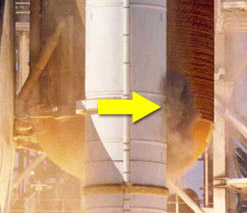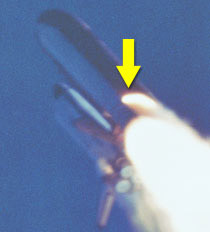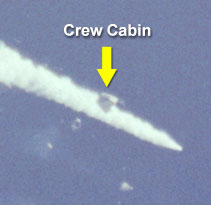What Really Happened on
January 28, 1986
On January 28, 1986, the world was stunned when the Space Shuttle Challenger broke apart just 73 seconds into flight, leading to the death of all seven of its crew members. The spacecraft disintegrated over the Atlantic Ocean off the East coast of Florida at 11:38 EST. It was the worst tragedy to strike our nation since the assassination of President John F. Kennedy. The accident resulted in a 32-month suspension of the Space Shuttle program. President Ronald Reagan appointed a special commission known as the Rogers Commission to investigate the accident and determine its cause.

The investigation centered around the O-rings in the shuttle's solid rocket boosters. Several videos of the launch appeared to show a plume of flame emanating from one of the lower joints on the right booster. NASA managers had been concerned about a potentially catastrophic flaw in the design of the O-rings since 1977, but failed to address it properly. They also disregarded warnings from engineers about the dangers of launching in low temperatures and had failed to report these concerns to their superiors. The temperature on the morning of the launch was well below freezing and it was discovered that the O-rings were only qualified to function properly down to 40 degrees. The temperature reached 18 degrees Fahrenheit the night before the launch. Ice was visible on the launch tower just hours before launch. Morton Thiokol, the manufacturer of the solid rocket boosters, recommending delaying the launch because of the low temperatures. However, after reviewing all of the available data, launch managers cleared the spacecraft for launch.

Challenger lifted off the launch pad at 11:38 AM EST on the morning of January 28. It appeared by all measures to be a routine launch. However, a review of the launch video showed dark puffs of smoke emitted from the right rocket booster near the base of the main fuel tank. This was caused by metal buckling around the joint due to the force of the launch. This had been seen on previous flights, but the O-ring had always filled the gap and prevented any further leakage. However, due to the extremely low temperatures, the O-ring had become too hard to properly fill the gap. At about 58 seconds into launch, a plume of flame began to appear at the booster joint where the smoke had been seen. This plume began to burn through the casing of the external fuel tank, which contained volatile liquid hydrogen and liquid oxygen. AT 73 seconds into launch, the fuel tank failed, causing the liquid hydrogen and oxygen to mix and ignite. This caused the main fuel tank to explode. The solid rocket boosters separated and flew away uncontrollably. Without its fuel source to keep it on target, Challenger was subjected to extremely high aerodynamic forces. These forces caused the orbiter to break apart. The crew cabin detached and remained intact. It was determined that the crew survived and was still alive at this point. It is believed that they perished when the crew cabin crashed into the ocean several seconds later.

The Rogers Commission concluded that it was the faulty booster seal design combined with the unusually low temperatures that caused the accident. They also cited both NASA and Morton Thiokol for failing to respond to the danger posed by the faulty booster design. The Space Shuttle fleet was grounded for almost three years following the accident. During this time, the solid rocket boosters were totally redesigned. The redesign was overseen by an independent oversight group. NASA also made a number of operational and procedural changes to ensure that any future concerns prior to launch would be fully addressed. On September 29, 1988, the shuttle program resumed operations with the launch of Discovery on mission STS-26. The flight was successful and the new booster design was proven to be safe.




